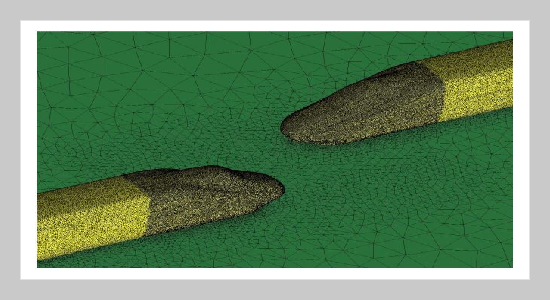Lin Ma 1, Zihao Xie1, Weiyu Chen1, and ZhenfengWu1
1School of Mechatronic Engineering, Lanzhou Jiaotong University, Lanzhou 730070, China
Received:
March 24, 2021
Accepted:
June 13, 2021
Publication Date:
September 29, 2021
Copyright The Author(s). This is an open access article distributed under the terms of the Creative Commons Attribution License (CC BY 4.0), which permits unrestricted use, distribution, and reproduction in any medium, provided the original author and source are cited.
Download Citation: ||https://doi.org/10.6180/jase.202204_25(2).0016
ABSTRACT
The strength of side windows, the stability of train operation, and the comfort of passengers will be affected by air pressure fluctuations when the high-speed train meets. Based on the three-dimensional, compressible, and unsteady two-equation turbulence model, the moving grid technique and the finite volume method were applied to simulate the high-speed train meeting in the open air with nose-slenderness ratios of λL1=3.43, λL2=5.01, λL3=6.59 respectively, and the pressure curves of seven monitoring points near the side window of the train are obtained. The results show that when trains with different slenderness ratio meet at the same speed, the train with smaller nose-slenderness ratio will suffer greater aerodynamic impact. When the three trains with different slenderness ratio meet at the same speed with the same observing train, the train with a larger nose-slenderness ratio has smaller amplitude of the head pressure wave and the tail pressure wave, while the train with a smaller nose-slenderness ratio has larger amplitude of the two kinds of pressure wave. The reduction rate range of head pressure wave amplitude is 16.0-43.3% and that of the tail one is 13.5-32.1%. It can be seen that the air pressure pulse amplitude of trains crossing in the open air can be reduced by increasing the nose-slenderness ratio of the train.
Keywords:
train crossing, numerical simulation, high-speed train, aerodynamic performance
REFERENCES
- [1] X.-j. LI, C.-h. LIU, and G.-w. YANG, (2012) “Characteristics of pressure wave induced by high speed trains meeting in open air" Science Technology and Engineering 15:
- [2] H. Tian, (2007) “Train Aerodynamics" Beijing: China Railway Publishing House:
- [3] L. Renxian, L. Jie, Q. Zhendang, et al., (2011) “Air pressure pulse developing regularity of high-speed trains crossing in open air" Journal of Mechanical Engineering 47(4): 125–130. DOI: 10.3901/JME.2011.04.125.
- [4] Z. Wu, E. Yang, and W. Ding, (2017) “Design of large-scale streamlined head cars of high-speed trains and aerodynamic drag calculation" Archives of Transport 44: DOI: 10.5604/01.3001.0010.6164.
- [5] H. E. Kan, Y. Hou, G. Gao, J. Zhang, F. Xie, Y. Zhang, and Y. Zhang, (2017) “Research on flow field around high-speed trains affected by varying major molded lines of head car" Journal of Railway Science and Engineering:
- [6] K. Fujii and T. Ogawa, (1995) “Aerodynamics of high speed trains passing by each other" Computers & fluids 24(8): 897–908. DOI: 10.1016/0045-7930(95)00024-7.
- [7] R. S. Raghunathan, H.-D. Kim, and T. Setoguchi, (2002) “Aerodynamics of high-speed railway train" Progress in Aerospace sciences 38(6-7): 469–514.DOI: 10.1016/S0376-0421(02)00029-5.
- [8] M. Zhang, Y. Yang, L. Lu, and C. Fan, (2011) “Numerical Simulation of Flowfield around High Speed Trains Passing by each other at the same Speed" Applied Mechanics and Materials 97-98: 698–701. DOI: 10.4028/www.scientific.net/AMM.97-98.698.
- [9] Z. Sun, Y. Zhang, D. Guo, G. Yang, and Y. Liu, (2014) “Research on running stability of CRH3 high speed trains passing by each other" Engineering Applications of Computational Fluid Mechanics 8(1): 140–157. DOI:10.1080/19942060.2014.11015504.
- [10] Y. Mei, J. Sun, J. Xu, and C.-h. ZHOU, (2015) “Crossing pressure wave characteristics of high-speed trains in tunnel" Journal of Traffic and Transportation Engineering 15(5): 34–43.
- [11] X. Yan-hong, M. Jun, L. Run-dong, et al., (2016) “A probe into air pressure pulse amplitude of high-speed trains crossing in open air" Journal of South China University of Technology: Nature Science Edition 44(3): 118–127. DOI: 10.3969/j.issn.1000-565X.2016.03.017.
- [12] Y.-g. Chen and Q. Wu, (2018) “Study on unsteady aerodynamic characteristics of two trains passing by each other in the open air" Journal of Vibroengineering 20(2):1161–1178. DOI: 10.21595/JVE.2018.18695.
- [13] N. J. Zhou Dan Jia Lirong, (2018) “Numerical simulation of impact of train length on alternating pressure load" Journal of Railway Science and Engineering 015(001): 1–7.
- [14] S. Huang, Z. Li, and M. Yang, (2019) “Aerodynamics of high-speed maglev trains passing each other in open air" Journal of Wind Engineering and Industrial Aerodynamics 188: 151–160. DOI: 10.1016/j.jweia.2019.02.025.
- [15] W. Khier, M. Breuer, and F. Durst, (2000) “Flow structure around trains under side wind conditions: a numerical study" Computers & Fluids 29(2): 179–195. DOI: 10.1016/S0045-7930(99)00008-0.
- [16] Z. Wu, Y. Huo, W. Ding, and Z. Xie, (2018) “Bionic shape design of electric locomotive and aerodynamic drag reduction" Archives of Transport 48: DOI: 10.5604/01.3001.0012.8369.
- [17] R. LI, J. ZHAO, J. Liu, et al., (2010) “Influence of air pressure pulse on side windows of high-speed trains passing each other" Journal of Mechanical Engineering 4: 87–92. DOI: 10.3901/JME.2010.04.087.
- [18] T.WANG, (2013) “Based on CRH6 Type of High-speed Train Train Development Appearance Design of Research" Railway Locomotive & Car:
- [19] Z.-w. LI, X.-f. LIANG, and D. ZHOU, (2008) “Aerodynamic performance for container flat wagon passing in open air and in tunnel" Journal of Central South University (Science and Technology) 5:
- [20] L. M. Zhou and C. J. Chen, (2017) “Analysis of Passing PressureWave Characteristics of Ordinary Fast Train and EMU" Machinery Design & Manufacture:
- [21] S.-S. Ding, Q. Li, A.-Q. Tian, J. Du, and J.-L. Liu, (2016) “Aerodynamic design on high-speed trains" Acta Mechanica Sinica 32(2): 215–232. DOI: 10.1007/s10409-015-0546-y.
- [22] T. Li, J. Zhang, and W. Zhang, (2011) “An improved algorithm for fluid-structure interaction of high-speed trains under crosswind" Journal of modern transportation 19(2): 75–81. DOI: 10.3969/j.issn.2095-087X.2011.02.001.
















